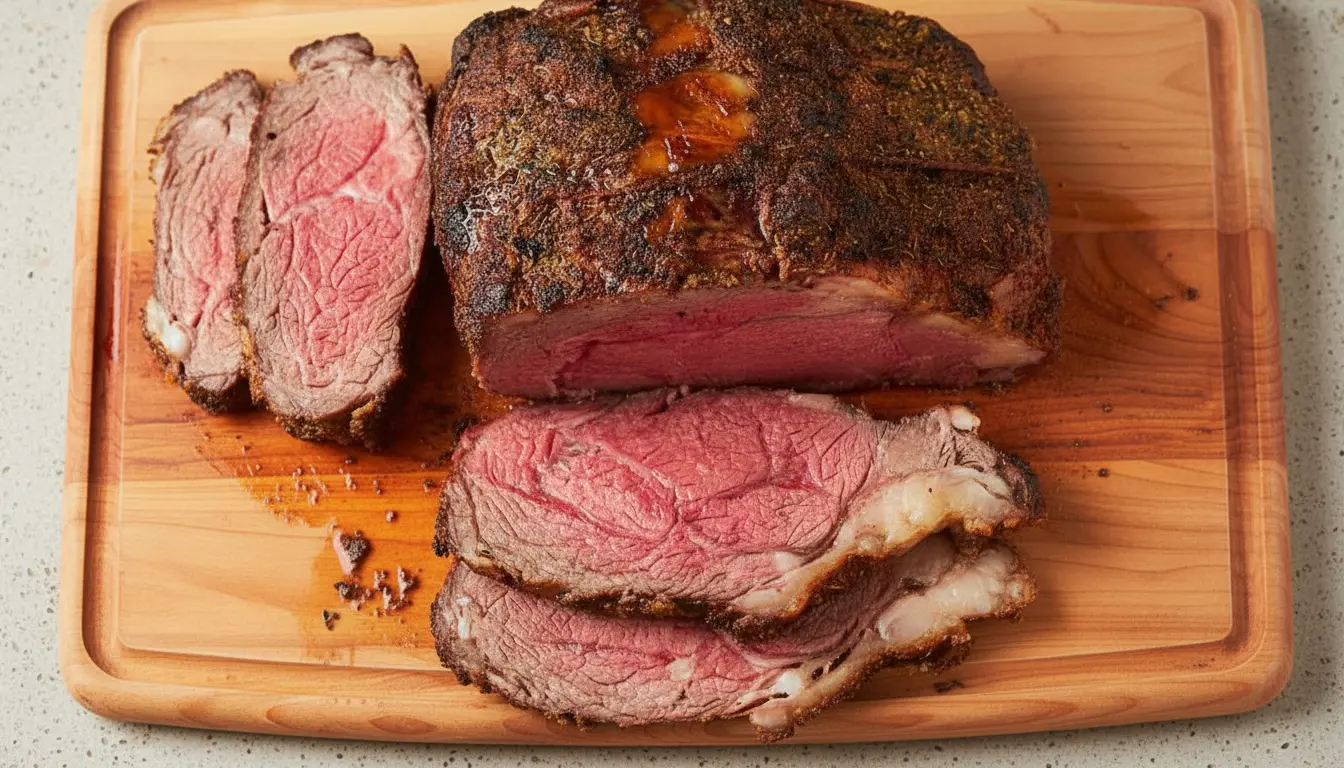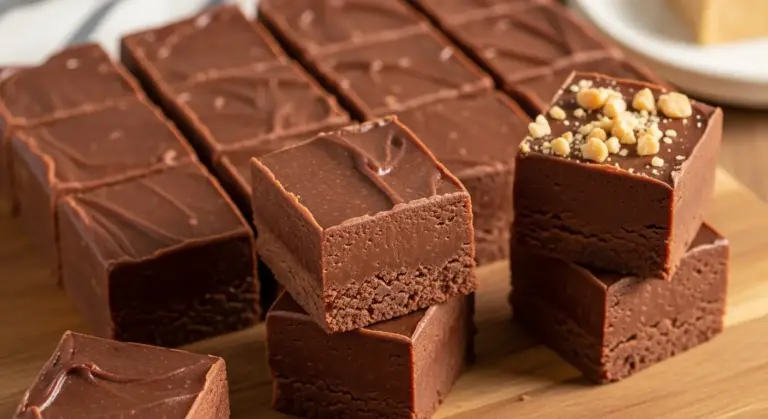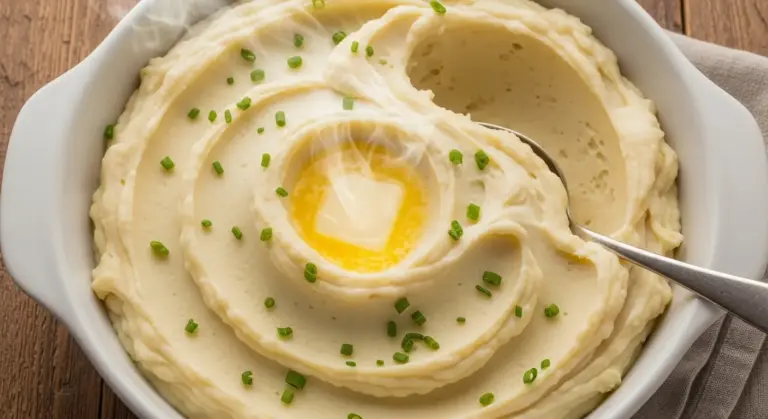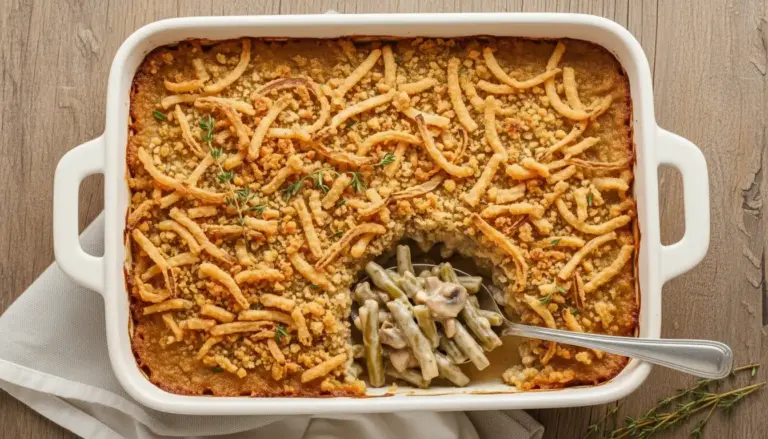I’ll never forget the first time I decided to tackle a prime rib recipe at home instead of paying $45 a plate at a steakhouse. My hands were sweating, honestly, as I prepped this massive cut of beef, worried I’d somehow ruin it.
That nervousness melted away the moment I pulled it out of the oven and saw that perfectly pink center surrounded by a gorgeous golden crust. Since that fateful dinner, I’ve made prime rib dozens of times, and I want to share exactly how I do it so you can have that same restaurant-quality experience in your own kitchen.
| Quick Recipe Summary | |
|---|---|
| Prep Time | 20 minutes |
| Cook Time | 2 hours 15 minutes (for medium-rare) |
| Total Time | 2 hours 35 minutes |
| Servings | 8-10 people |
| Difficulty Level | Moderate |
Why You’ll Love This Prime Rib Recipe
This prime rib recipe delivers restaurant-quality results without the restaurant markup. The combination of proper seasoning, high heat searing, and precise temperature monitoring creates a beef masterpiece.
What makes this approach different is the reverse sear method: low and slow cooking followed by a high-heat blast at the end, which gives you edge-to-edge perfect doneness instead of that frustrating rare center with overdone edges.
- Incredibly juicy interior with no dry, overcooked meat
- Perfect crust on the outside for maximum flavor
- Foolproof temperature monitoring eliminates guesswork
- Elegant enough for holiday dinners yet simple enough for practice
- Leftovers make incredible sandwiches (if you have any leftovers)
- Impresses guests without keeping you trapped in the kitchen
I learned the hard way that skipping the rest period before cooking is a mistake. The first prime rib I made started cold, and the results weren’t as consistent as they should have been.
Once I started bringing the meat to room temperature for 30-40 minutes before cooking, everything changed. Now every roast comes out perfect.
Read Also: Slow Cooker Pot Roast
Ingredients
This is a relatively simple recipe because when you’ve got quality beef and smart seasoning, you don’t need much else. I always go for a bone-in rib roast because the bones conduct heat beautifully and add incredible flavor to the jus.
- 1 standing prime rib roast (4-5 kg / 8-10 pounds), bones in
- 3 tablespoons (45g) kosher salt
- 2 tablespoons (12g) freshly cracked black pepper
- 2 tablespoons (8g) fresh rosemary, finely chopped
- 2 tablespoons (8g) fresh thyme leaves
- 6 cloves garlic, minced
- 3 tablespoons (45ml) high-quality olive oil
- 2 tablespoons (28g) Dijon mustard
- 1 cup (240ml) red wine
- 2 cups (480ml) beef broth
- 2 tablespoons (14g) cornstarch
- 2 tablespoons (30ml) cold water
Kitchen Equipment Needed
Having the right tools makes this process infinitely easier and more accurate. The meat thermometer is absolutely essential because it’s the only way to guarantee perfect doneness without cutting into the roast and releasing those precious juices.
- Heavy-duty cast iron roasting pan with high sides
- Instant-read meat thermometer
- Sturdy carving knife (8-10 inch)
- Sharp chef’s knife (for prep)
- Cutting board
- Aluminum foil
- Meat tongs
- Measuring spoons and cups
- Small bowl for herb mixture
- Wooden spoon or silicone spatula
Read also: Crockpot Beef Stew Recipe
Recommended Products for This Recipe
Over the years, I’ve invested in equipment that genuinely transforms the prime rib cooking experience. These are the specific products I use regularly and recommend based on real kitchen testing.
1. Instant-Read Meat Thermometer
This might be the single most important investment for perfect prime rib. I use mine for every roast, and the accuracy takes all the guesswork out of doneness levels. Being able to check the temperature in 3 seconds flat means you’ll never overcook your expensive beef.
2. Heavy-Duty Cast Iron Roasting Pan
A quality cast iron roasting pan heats evenly and develops an incredible sear on the bottom of the roast. The heat retention means your crust stays gorgeous while the interior stays juicy, and it lasts for decades.
3. Premium Beef Thermometer with Probe
For those who want next-level precision, a oven-safe probe thermometer alerts you when the roast reaches your target temperature. It eliminates the need to repeatedly open the oven and lose heat.
4. Professional Carving Knife Set
A sharp carving knife makes slicing through the prime rib a breeze and ensures beautiful presentation. Dull knives shred the meat and squeeze out those lovely juices you worked so hard to keep in.
5. High-Quality Kosher Salt and Peppercorn Set
The seasoning quality matters more than people realize. Good kosher salt and fresh peppercorns make a noticeable difference in the final crust and flavor profile.
Step-by-Step Instructions: How to Make Prime Rib
1. Prepare Your Prime Rib and Equipment
- Remove your prime rib roast from the refrigerator 40 minutes before cooking. Room temperature meat cooks more evenly than cold meat straight from the fridge. The interior will reach your target temperature while the exterior develops that perfect crust without overcooking.
- Place your oven rack in the lower third position and preheat your oven to 200°C (400°F). You’ll start at this moderate temperature to allow even cooking throughout, then blast it at the end for a gorgeous crust.
- Pat the prime rib completely dry with paper towels. Any moisture on the surface prevents proper browning, so be thorough here. Moisture creates steam instead of the Maillard reaction that builds flavor.
- Inspect the bones and trim away any loose fat or silver skin on top. You want to keep the fat cap intact but remove anything that won’t contribute to the final dish.
2. Create and Apply the Herb Crust
- Combine 3 tablespoons (45g) kosher salt, 2 tablespoons (12g) black pepper, 2 tablespoons (8g) fresh rosemary, 2 tablespoons (8g) fresh thyme, and 6 minced garlic cloves in a small bowl. Fresh herbs make a dramatic difference compared to dried, so don’t skip this step.
- Add 3 tablespoons (45ml) olive oil to your herb mixture and stir until you have a thick paste. This paste is what creates that flavorful crust while the meat cooks.
- Rub this herb paste all over the top and sides of the prime rib, working it into every crevice. The bones naturally create pockets where the herbs settle and toast beautifully during cooking.
- Flip the roast and rub 2 tablespoons (28g) Dijon mustard on the bottom. The mustard won’t taste like mustard in the final dish but adds complexity and helps the crust develop.
- Generously season the bottom with additional salt and pepper. Don’t be shy here; you want flavor throughout.
3. Sear the Prime Rib
- Heat your cast iron roasting pan over high heat on the stovetop for 3-4 minutes until it’s very hot. You should be able to hold your hand 5 inches above the surface and feel intense heat.
- Carefully place the prime rib bone-side down in the hot pan. You’ll hear an immediate sizzle, which is exactly what you want. This is the Maillard reaction beginning, which creates all that delicious crust flavor.
- Sear for 3-4 minutes without moving the roast. Resist the urge to fidget with it; letting it sit develops a gorgeous brown crust on the bottom.
- Using tongs, carefully flip the roast to sear the herb-crusted top for another 3-4 minutes. If there’s a thin fat cap on the sides, sear those edges as well by holding the roast with tongs.
- Once all sides have color, remove the roast and place it bone-side down in your roasting pan.
4. Cook to Perfect Doneness
- Insert your meat thermometer into the thickest part of the meat, making sure it doesn’t touch bone, which conducts heat differently and gives false readings. This placement is crucial for accurate temperature monitoring.
- Place the pan in your preheated 200°C (400°F) oven. For a 4-5 kg (8-10 pound) roast, you’ll need approximately 1.5-2 hours, depending on your oven’s accuracy and your desired doneness.
- Check the temperature every 30 minutes starting at the 1-hour mark. You’re aiming for 48-50°C (118-120°F) for medium-rare, which will coast to 54-57°C (130-135°F) after resting.
- When the internal temperature reaches 48°C (118°F), increase the oven temperature to 232°C (450°F) for the final sear. This high heat will raise the internal temperature by another 5-8°C (10-15°F) while creating an exceptional crust.
- Roast for another 15-20 minutes at this higher temperature until the internal temperature reaches 54°C (130°F) for medium-rare. Remove from oven and transfer to a cutting board.
5. Rest Your Prime Rib
- Tent the roast loosely with aluminum foil and let it rest for at least 15 minutes. This resting period is non-negotiable because it allows the juices to redistribute throughout the meat instead of running onto the cutting board.
- While the roast rests, make your red wine jus by placing the roasting pan over medium-high heat on the stovetop. Pour in 1 cup (240ml) red wine and use a wooden spoon to scrape up all the flavorful brown bits stuck to the bottom.
- Simmer the wine for 2-3 minutes to reduce it by half, concentrating the flavor. Add 2 cups (480ml) beef broth and simmer for another 3-4 minutes.
- Make a slurry by mixing 2 tablespoons (14g) cornstarch with 2 tablespoons (30ml) cold water. Slowly whisk this into the simmering jus to thicken it slightly, creating a luxurious sauce without heavy cream.
- Strain the jus through a fine mesh strainer into a serving vessel, leaving behind any herb bits or fat you don’t want.
6. Carve and Serve
- After the 15-minute rest, place your prime rib back on a large cutting board. Using a sharp carving knife, cut between the bones first to separate the roast into individual bone sections.
- Slice each section perpendicular to the grain into 2-3 cm (about 1-inch) thick slices. Slicing perpendicular to the grain shortens the muscle fibers, making each bite tender.
- Arrange slices on a warm platter with a bone leaning against them for presentation. Serve immediately with the red wine jus on the side.
Learn more about mastering other elegant proteins by checking out my filet mignon recipe, which uses similar high-heat searing techniques.
Tips for The Best Prime Rib
Over dozens of prime ribs, I’ve learned techniques that transform good results into exceptional ones. These tips come from real mistakes and happy accidents in my kitchen.
- Always bring your roast to room temperature before cooking. This simple step ensures the interior reaches your target temperature without the exterior overcooking. A cold roast right from the fridge will have an overcooked exterior by the time the center reaches medium-rare.
- Invest in a quality meat thermometer and use it religiously. This is your insurance policy against dry, overcooked beef. Don’t rely on the “touch test” or cooking time charts because ovens vary wildly.
- Use fresh herbs instead of dried. The flavor difference is remarkable, especially in a dish this simple where every ingredient matters.
- Don’t skip the searing step. That initial high-heat sear creates the flavorful crust that makes prime rib special. Skipping it results in gray, unappetizing meat.
- Target medium-rare doneness (54-57°C / 130-135°F internal temperature) rather than medium or beyond. The muscle structure of prime rib stays more tender and juicy at these lower temperatures.
- Let the roast rest for at least 15 minutes after cooking. The internal temperature will rise 3-5°C (5-10°F) during this time, so account for carryover cooking.
- Use the drippings and pan to make jus. Those brown bits contain concentrated flavor that transforms your side dishes when drizzled over potatoes or vegetables.
- Choose a roast with good marbling (those small white fat lines throughout). This intramuscular fat melts during cooking and keeps the meat juicy.
- Ensure your oven is properly preheated with an oven thermometer to verify accuracy. Many home ovens run 10-15°C (20-30°F) off from their dial setting.
You might also enjoy: Mississippi Pot Roast, another beef centerpiece that’s equally impressive but uses a completely different cooking method.
Serving Suggestions
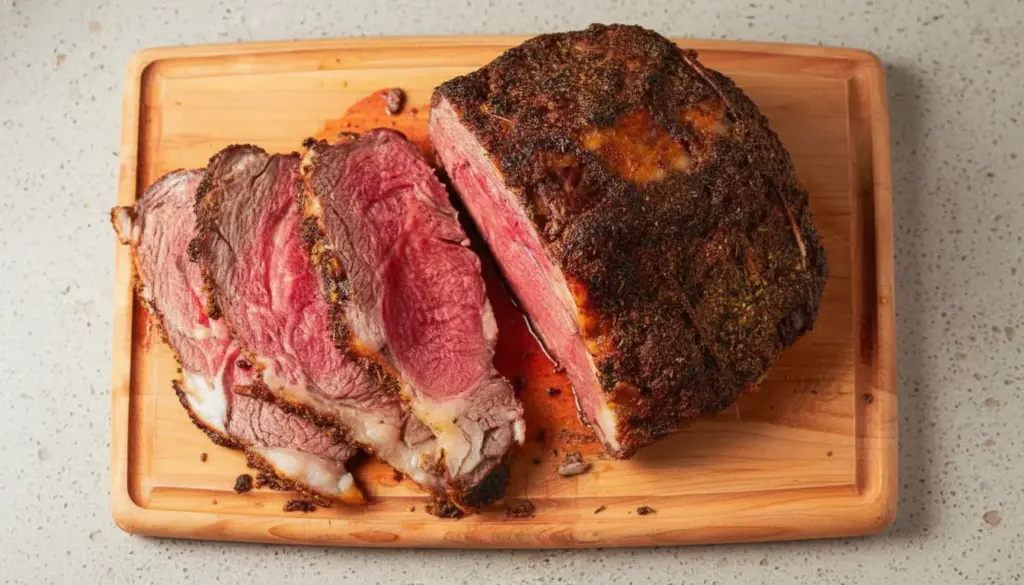
Prime rib demands thoughtful side dishes that complement its richness without competing for attention. The beauty of this showstopper is that simple, classic sides work best.
- Creamed spinach pairs beautifully with prime rib because it cuts through the richness with its slight earthiness. Top it with crispy shallots for texture contrast.
- Twice-baked potatoes add elegance to the plate and can be prepared ahead of time, which takes pressure off your cooking schedule. Fill them with sour cream, cheese, and bacon.
- Creamy mashed potatoes are a no-brainer. They’re a canvas for that incredible red wine jus you spent time perfecting.
- Roasted asparagus with garlic shows the roast respect with its simple preparation. The slight char from the oven complements the crusty exterior of the beef.
- A fresh arugula salad with lemon vinaigrette provides brightness that balances the heaviness of the prime rib beautifully. The peppery arugula echoes the herb crust.
- Roasted garlic and herb roasted root vegetables create an earthy, comforting plate alongside the beef.
- Yorkshire pudding harks back to traditional British roasts and creates an elegant presentation. The slightly sweet, puffy texture works surprisingly well.
- Green bean casserole provides nostalgic comfort without being overly heavy. Use fresh green beans if you can for better texture.
Read Also: Dinner Rolls
Variations of Prime Rib
While the classic preparation is exceptional, sometimes you want to explore different flavor profiles. These variations maintain the core cooking technique while taking the dish in new directions.
- Coffee and cocoa rub creates an unexpected depth by adding 2 tablespoons (10g) finely ground coffee and 1 tablespoon (5g) unsweetened cocoa powder to your herb mixture. The coffee deepens the savory notes while cocoa adds subtle complexity.
- Asian-inspired version uses a marinade of soy sauce, ginger, garlic, and sesame oil instead of fresh herbs. This transforms the flavor profile entirely while maintaining the cooking method.
- Smoke-roasted prime rib combines the traditional oven method with liquid smoke added to your herb rub. This gives you barbecue flavor with the precision of oven cooking.
- Mediterranean herb version incorporates oregano, marjoram, and a touch of lemon zest into your herb paste. This lighter approach appeals to those who find the traditional version too rich.
- Garlic and truffle prime rib uses triple the garlic and adds 1 tablespoon (15ml) truffle oil to your jus. This elevated variation is spectacular for special occasions.
- Herb butter crust replaces the oil with softened butter mixed with your herbs, creating a richer, more luxurious exterior crust.
For more elegant protein options, check out my tandoori chicken recipe, which uses similar herb-forward cooking techniques.
Storage and Reheating
Proper storage ensures you can enjoy your prime rib for several days, and the leftovers are genuinely as delicious as the original meal when reheated correctly.
- Cool leftover prime rib completely before storing. Placing hot food in the refrigerator raises the temperature and can encourage bacterial growth.
- Slice your leftover prime rib against the grain into pieces roughly 3 mm (1/8-inch) thick. This makes reheating more even and faster.
- Store prime rib in an airtight container with its jus for up to 4 days in the refrigerator. The jus keeps the meat from drying out during storage.
- For freezing, wrap individual slices tightly in plastic wrap, then place them in a freezer bag with the date marked. Frozen prime rib keeps for up to 3 months.
- Reheat sliced prime rib gently in a low oven (120°C / 250°F) wrapped in foil for about 10-15 minutes. Gentle heat prevents further cooking and moisture loss.
- Make incredible sandwiches with leftovers on crusty bread with a bit of jus spooned on top. These sandwiches are honestly better than the original meal.
- Shred leftover prime rib and use it in beef fried rice or grain bowls for a completely different dish that still showcases the meat’s quality.
You might also like: The Best Beef Barley Soup Recipe for Cozy Fall Nights
Nutritional Facts
Per serving (based on 8 servings, approximately 6 oz / 170g cooked meat):
- Calories: 520
- Total Fat: 38g
- Saturated Fat: 16g
- Cholesterol: 95mg
- Sodium: 580mg
- Total Carbohydrates: 1g
- Dietary Fiber: 0g
- Protein: 48g
- Iron: 3.2mg (18% of Daily Value)
- Zinc: 8.5mg (58% of Daily Value)
- B12: 1.5mcg (63% of Daily Value)
- Selenium: 28mcg (51% of Daily Value)
Health Benefits of Key Ingredients
Beyond its incredible taste, prime rib offers genuine nutritional benefits when consumed as part of a balanced diet. Beef is far more nutrient-dense than many people realize.
- Beef provides complete protein containing all nine essential amino acids your body cannot produce, making it perfect for muscle maintenance and repair. A single serving of prime rib delivers nearly 50 grams of protein.
- Iron in beef is highly bioavailable heme iron, which your body absorbs more efficiently than plant-based iron sources. This makes prime rib particularly beneficial for iron-deficient individuals.
- Zinc supports immune function, wound healing, and protein synthesis. Prime rib contains 58% of the daily recommended zinc in a single serving.
- Vitamin B12 is essential for neurological function and red blood cell formation, and beef is one of the few naturally rich sources. Plant-based eaters often supplement because this nutrient is so abundant in meat.
- Selenium acts as an antioxidant and supports thyroid function. Prime rib contains over 50% of the daily recommended amount.
- Creatine supports cognitive function and muscle energy production. Beef is one of the few food sources of naturally occurring creatine.
- Carnosine and anserine are amino acid combinations found in beef that have antioxidant and anti-inflammatory properties not found in plant foods.
For more nutrient-focused recipes, try my healthy chicken parmesan recipe that balance indulgence with nutrition.
FAQs About Prime Rib
1. What’s the difference between prime rib and ribeye steak?
Prime rib refers to the whole roast including the bones, typically containing 7 ribs. Ribeye steaks are individual steaks cut from the same primal cut but without the bone.
Think of prime rib as the whole rib section, while ribeye is like slicing that section into individual steaks.
2. How far ahead can I season my prime rib?
You can season your prime rib up to 24 hours ahead of cooking. Salting the meat early allows the salt to penetrate deeper, creating more flavorful meat throughout rather than just on the surface.
If seasoning ahead, cover the herb-rubbed roast loosely with plastic wrap and refrigerate until 40 minutes before cooking.
3. Can I cook prime rib in a slow cooker?
While technically possible, slow cooking doesn’t develop the flavorful crust that makes prime rib special. The searing step creates complexity that low-and-slow cooking simply cannot replicate.
If you must use a slow cooker, sear the roast in a skillet first, then finish in the slow cooker on low heat while monitoring temperature carefully.
4. What size prime rib should I buy for my guest count?
Plan for approximately 450-600g (1-1.5 pounds) per person depending on appetite and side dishes. A 4-5 kg (8-10 pound) roast serves 8-10 people comfortably as your main protein.
Bone-in roasts provide more flavor than boneless options, so prioritize bone-in even though it looks like less meat.
5. How do I know when my prime rib is done?
Use a meat thermometer as your only reliable guide. Aim for 48-50°C (118-120°F) internal temperature before your final sear, which will coast to 54-57°C (130-135°F) after resting for medium-rare doneness.
Color and feel are unreliable because the residual heat and resting period change both dramatically.
Final Thoughts
That first prime rib I made was genuinely life-changing because it proved to me that restaurant-quality results are absolutely achievable at home with proper technique and quality ingredients. Every prime rib I’ve made since then has reinforced that conviction.
I hope you’ll try this prime rib recipe and discover the same confidence I felt the moment you pulled that gorgeous roast from the oven. Share your results in the comments or tag me on social media because I genuinely love hearing about your kitchen adventures.
Recommended:
- Filet Mignon Recipe
- Mashed Potatoes Recipe
- Creamed Spinach Recipe
- Green Bean Casserole Recipe
- Maple Glazed Carrots Recipe
- Dinner Rolls Recipe
- Slow Cooker Pot Roast Recipe
- Tandoori Chicken Recipe
- Apple Crisp Recipe
- Creamy Tomato Basil Soup Recipe

